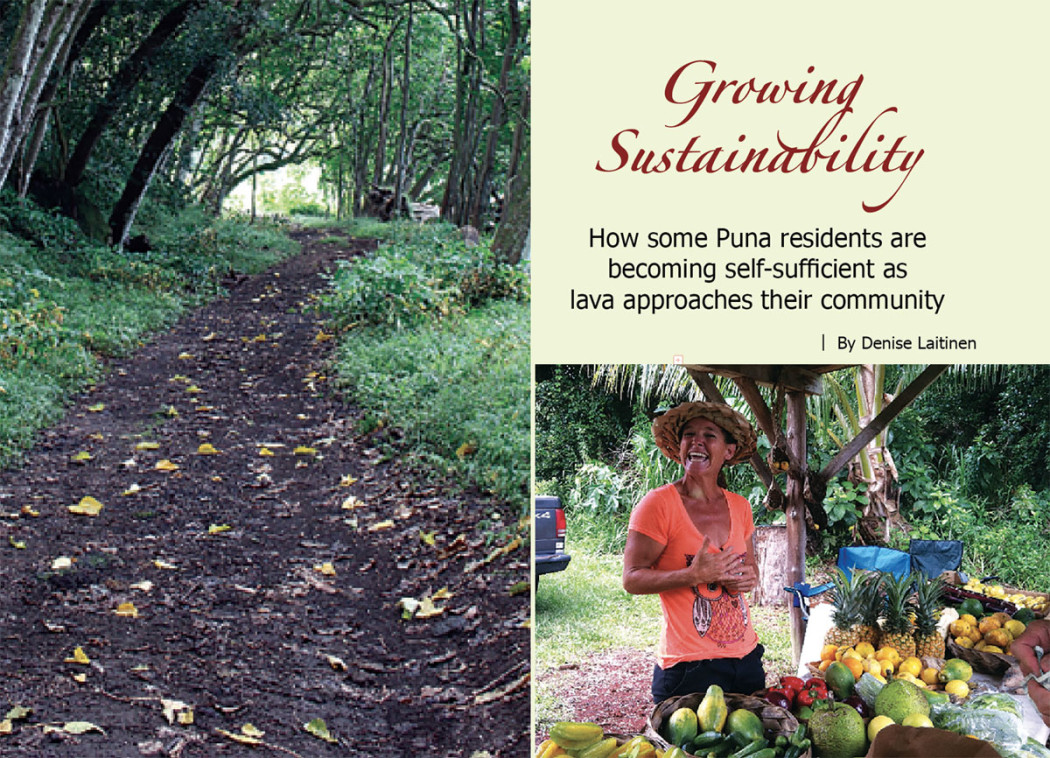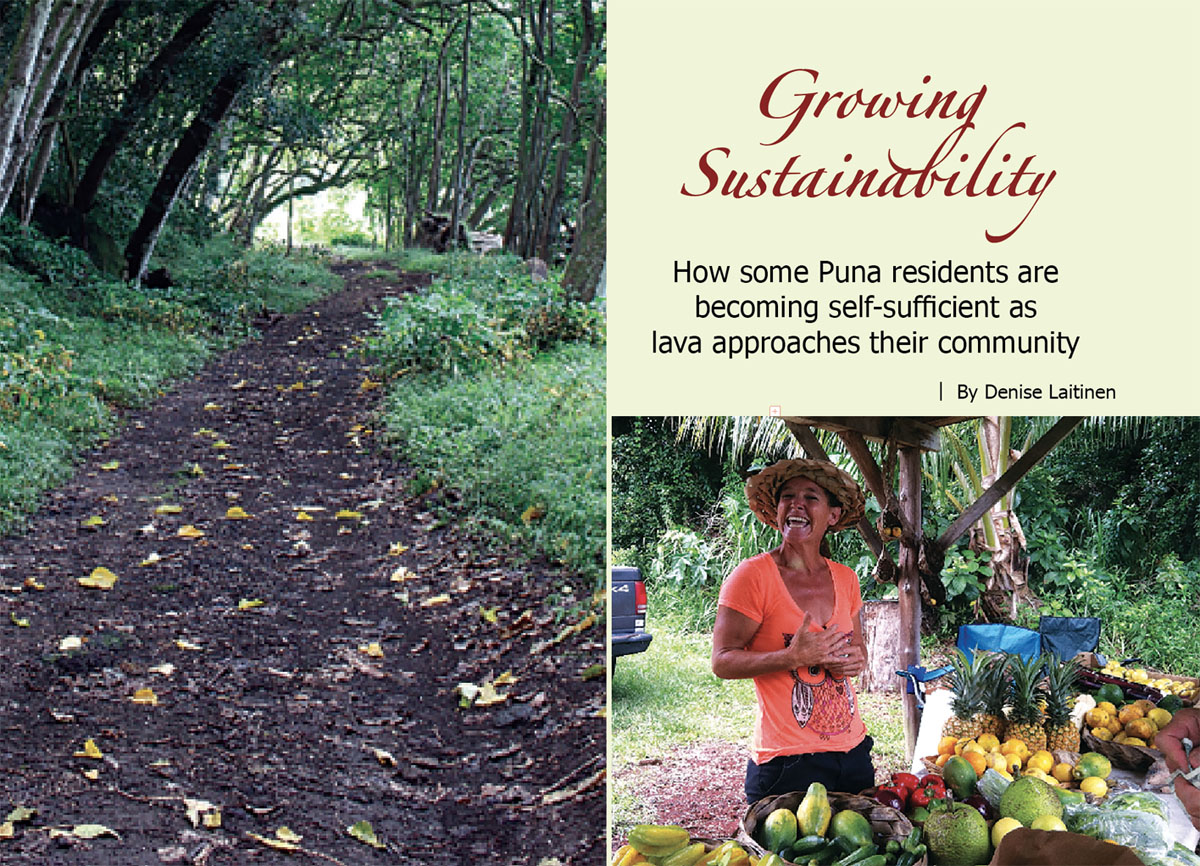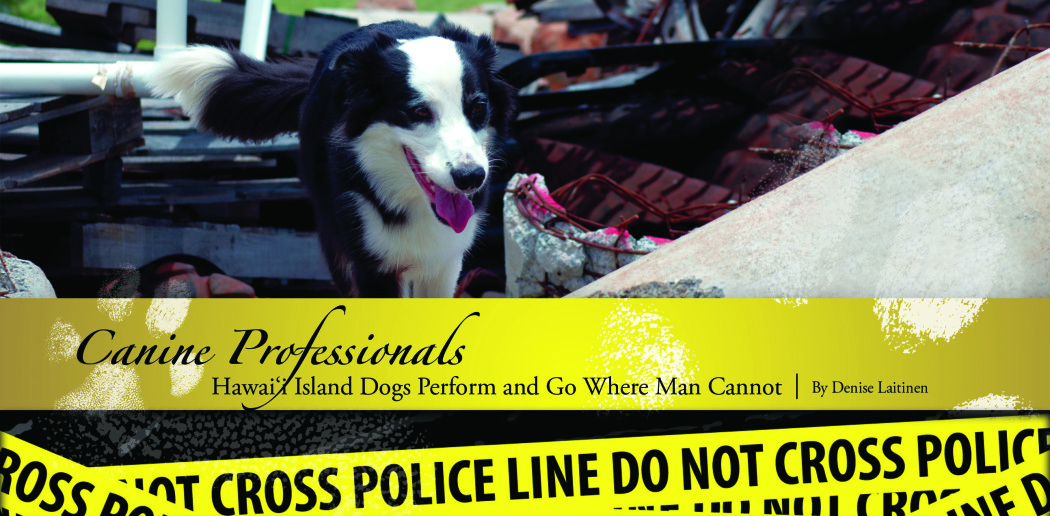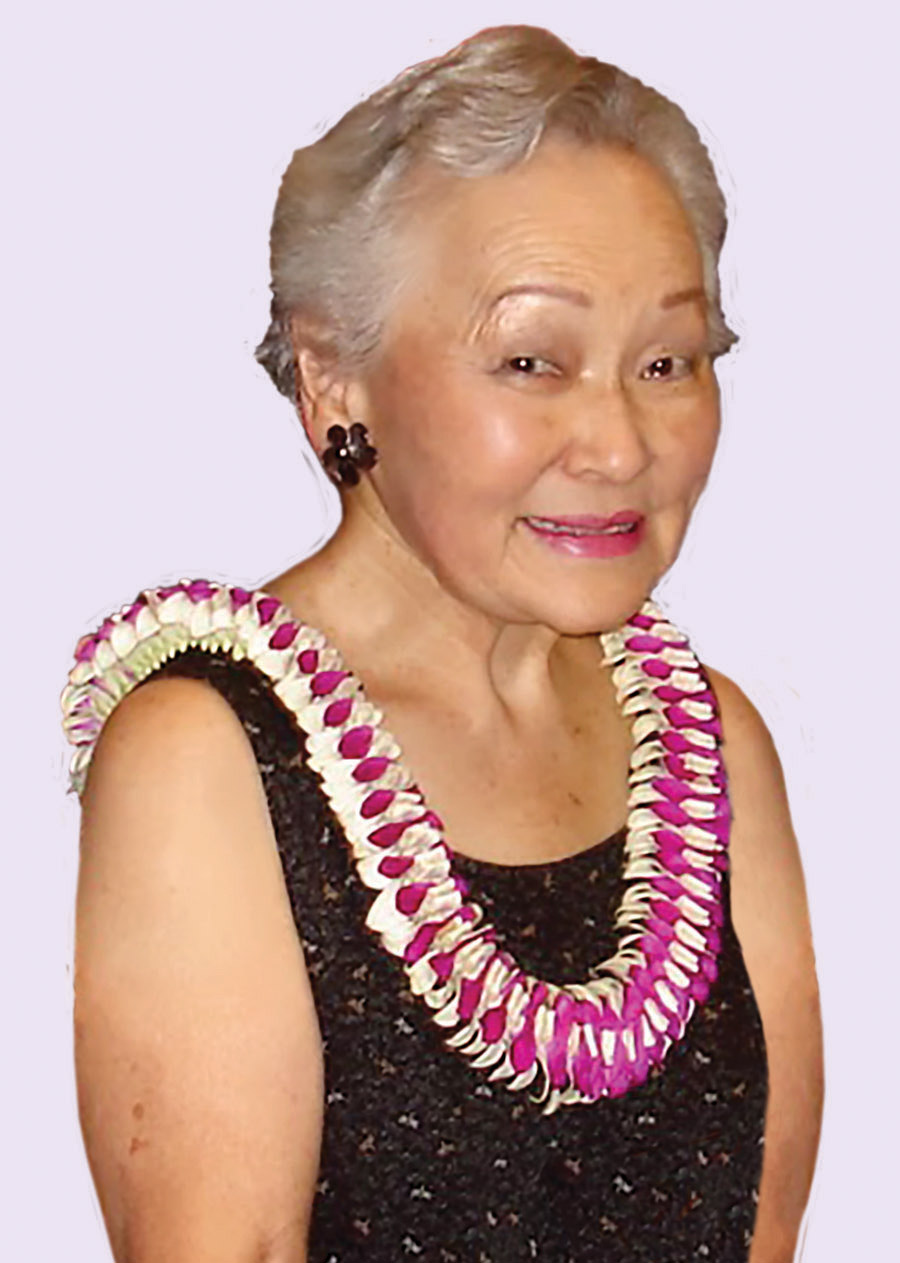
Growing Sustainability: How Some Puna Residents are Becoming Self-Sufficient as Lava Approaches their Community

By Denise Laitinen
Sustainability is a buzzword bandied about by a lot of people these days. Residents in two lower Puna communities believe the region, which is facing new realities as it is impacted by the lava flow, can serve as a model for the state and the entire country.
Some people, such as Graham Ellis, who has lived in Puna for three decades, have spent years building the foundation of self-sufficient communities, working at a legislative and community level.
Others, like Smiley Burrows of Kapoho, who is involved in farming, are now rapidly expanding their work due to the lava threat impacting lower Puna.

With plentiful rainfall and relatively inexpensive land, Puna, an area that covers roughly 500-square miles, has a long tradition of agriculture and tropical flower production. More than two-thirds of all papayas in Hawai‘i are grown in Puna, and the region is also home to the largest grafted tree nursery in the state.
According to a 2012 study, Puna supports 200 acres of banana production, more than 762 acres of tropical fruits, 2,709 acres of papaya, and more than 775 acres of tropical flowers and foliage (Delparte and Melrose).
Lower Puna, an area including the communities of Hawaiian Beaches, Kapoho, Pu‘ala‘a, Opihikao, Kehena, Kaimū, Seaview, and Kalapana, among others, is home to more than 9,400 residents. Because of the way several of the region’s subdivisions were planned and built over the past several decades, many of the region’s 3,891 households already use some form of sustainable energy practices, such as solar power or catchment water systems.
“We already have the highest rate of photovoltaic usage and the highest rate of water catchment systems,” says Graham. “And we can grow food year-round. We’re already at an advantage down here.”
What does it mean to be sustainable?
“Usually when people think sustainability, they think of food,” says Graham. “But food is about growing food, distributing food, and preparing food,” he continues.
Graham is one of the founders of the Hawaii Sustainable Community Alliance (HSCA), a grassroots, nonprofit organization created in 2010 dedicated to encouraging rural self-sufficiency, the use of ecological practices, expanding food production, meeting the needs for affordable housing, and reducing transportation costs. The group is comprised of more than 600 members, more than half of which are Puna residents or representatives of local community organizations.
Graham says HSCA decided to focus on changing local laws in order to better address the need for affordable housing. In 2011 they were successful in getting the Hawai‘i County Council to pass a resolution addressing an alternative building code: Sustainable Habitat Building Res #167-11. The Resolution requests the Department of Public Works to allow the use of substitute materials, procedures, and alternatives in the home building process and seeks to establish waivers and exemptions for owners/ builders of rural dwellings on agricultural lands.
“The resolution said that DPW should pass an alternative building code. That was our first success,” says Graham.
The resolution is currently being reviewed by the Department of Public Works.
In 2012, the group successfully worked to have the county council pass a second resolution urging the state legislature to support a bill for sustainable living resource sites: Sustainable Living Research Site Res. #302-12.
The sustainable living research site bill was passed in both the State House and Senate last year, but failed to make it out of a conference committee. Months later, the Puna community was devastated by Hurricane Iselle.
“The hurricane was a short-term disaster,” says Graham. “The number one lesson learned is that we can not rely on outside agencies.”
In the days after the storm, more than 33,000 Puna residents were without electricity or water; in some of the hardest hit neighborhoods, it took days before roads were cleared and people could leave their homes and neighborhoods.
HSCA began meeting weekly to address how communities could become more sustainable, bringing together a wide range of organizations and groups.
“We’ve had Hawai‘i Senator Russell Ruderman, Steve Harakami (principal of HAAS charter school in Pāhoa), former Mayor Harry Kim, representatives from local businesses, such as the Tin Shack Bakery, as well as organizations like Hawaiian Sanctuary, Kalani Honua, Hawai‘i Island United Way, the Department of Health, the Food Basket, and others.”
“Networking has proven to be the key,” Graham says. “That was a big lesson after the hurricane. Outside agencies did not know who the leaders were in the community here in Puna.”
Three weeks after Iselle, lava from the June 27 Kilauea lava flow began approaching the town of Pāhoa, sometimes advancing several hundred yards a day.
“The lava flow has been a huge wake up call,” says Graham. “What will the new normal become if the highway is cut off?” he asks.
It is estimated that should Highway 130 and the two evacuation routes makai (ocean side) of the Highway, Railroad Avenue and Beach Road, become unusable, lower Puna residents will have to drive more than 100 miles round trip to reach Hilo via Chain of Craters Road through Hawai‘i Volcanoes National Park. If that scenario becomes a reality, it will create increased hardship on an economic, societal, and personal level for residents throughout lower Puna.
Faced with this very possible reality, HSCA formed 11 different committees to address everything from communications to education and medical care in terms of how the community could become more self-sufficient.
Food was such an important component it was broken down into three committees.
“It’s no good if you’re growing food that people do not know how to prepare or cook. And it’s no good if you have no way to get the food to them,” Graham says, adding that HSCA recognizes the need for more local stores, not in the traditional sense of creating shopping centers like on the mainland, but more akin to decentralized village centers, similar to the sugar plantation camps of years past.
Should the lava prevent people from reaching Pāhoa or from easily reaching Hilo, “we’ll need to buy propane and gasoline,” says Graham. “We’re looking at shared transportation and shuttle services. We’ll need services, like if we need a tire fixed or a car repaired. We’ll need a medical clinic, a school. There are no commercially zoned lots in our district for that. So how do we resolve that? We’re in the process of addressing that right now.”
Part of that comes from working with elected officials. For instance, in terms of infrastructure, Senator Ruderman told Puna residents during a January legislative update meeting that he is preparing bills this session to allocate funding for a harbor and an airstrip to be created in Puna. Those projects might take years to be completed, but in the meantime, smaller business and groups are working on ways to support lower Puna.
In terms of medical care, should Highway 130 and evacuation routes become unusable, Graham says Bay Clinic will have a mobile clinic to serve lower Puna. Dr. Chris Lavinsky is moving his clinic from Hilo to Puna.
“We know that Pahoa Battery and Propane will have an outlet in Kaimū and that Kalani Honua is pursuing the opening of a commercial food store. SPACE (Seaview Performing Arts Center for Education) is planning to expand the school there,” Graham explains.
A local radio station serving the Red Road area is in the works and a network of local bulletin boards for posting community notices has already been created.
In the off weeks when HSCA is not meeting, members go on neighborhood farm tours to learn about local production capabilities. They also reach out to other organizations across the island. For instance, HSCA is in contact with a North Kohala group called No Food Left Behind, to learn about their projects gleaning food from fruit trees that are not being harvested.
Regardless of the impact of the lava, Graham says HSCA will continue to work toward creating communities where people are self-reliant, resource conserving, equitable, and ecologically restorative, while providing a good quality of life for community members and future generations.
“This is a lifestyle we need to move towards and Madame Pele is encouraging us to move towards it,” says Graham.
The lava flow is also serving as an impetus for residents in the Kapoho community to become more self-reliant.
Smiley Burrows, caretaker for the 256-acre property known as Green Mountain in Kapoho says, “My vision is to emulate a system where we are micro-economically working and the majority of the needs that we have are going to be met by the individuals that live here in the lower Puna area. We definitely have the farmers, as well as a wide array of incredibly gifted and talented people.”
As caretaker of Green Mountain, Smiley is uniquely positioned to spearhead community sustainability efforts.
Rising 400 feet above sea level, Green Mountain is a well-known landmark in lower Puna steeped in historical and cultural significance. The top of Green Mountain is called Ha‘e Ha‘e in Hawaiian, meaning gateway to the sun. It’s the first peak the sun touches in Hawai‘i every morning as it rises. In 1823, missionary Robert Ellis described Green Mountain as a, “singularly beautiful scene” with “luxuriant gardens” producing bananas, sugar cane, taro, and breadfruit.
Green Mountain is also home to Ka Wai of Pele, (the water of Pele) known as Green Lake, one of only two natural lakes on Hawai‘i Island.
A midwife by training, Smiley befriended William Appleton, the owner of Green Mountain, shortly after moving to lower Puna in 1997. Since 2001, she and her family have cared for the property, slowly restoring it.
Although Ellis described a veritable ‘Garden of Eden’ when writing of his travels to Kapoho in 1823, the land had fallen out of use by the time Smiley became caretaker.
“People would literally bring their kitchen sink and squat here,” says Smiley. “We could not hold a wedding here without 10 naked hippies popping out of the woodwork.”
In 2006, Smiley and her husband, Jerald, gated the entrance to Green Mountain and increased their farming efforts.
Four years ago, she started a Friday farmers market with fruit and vegetables grown both at Green Mountain and nearby farms.
“We started out cleaning up the banana patches, which had become overgrown. We had a large field of corn, so we decided to sell that at the market, too; then, started working on the coconut groves, and we planted lots of avocadoes.
Currently, they are growing kalo, tomatoes, arugula, pineapples, eggplant, turnips, radishes, beets, cucumbers, green peppers, among other fruits and vegetables.
As lava from the June 27 Kilauea lava flow was making its way down the hill and approaching Pāhoa, residents realized they would face increased hardships if Highway 130 became impacted by the lava flow and rendered unusable.
Last October, more than 50 area residents gathered at Green Mountain to discuss how they can become a self-sufficient community.
We asked ourselves, “What are the top 50 things you need to live in lower Puna?” says Smiley. “What are the top things that we need to live? What do we need to bring in—what can we create here? How do we go about doing it appropriately?”
Food production is a large part of becoming sustainable, which is why Smiley has made space available for people to grow their own food at Green Mountain.
“We’ve opened it up to anyone who wants to join us and start growing their own food,” says Smiley.
Volunteer gardening days are held every Monday, and nearby Kapoho residents like Kevin Kushel are already generating produce from crops planted last fall.
Like Graham, Smiley knows it is not enough to grow the food; they have to make it easily accessible to area residents. “Here in Kapoho we are in need of a community store,” says Smiley.
“We want to create a larger market for the community from Kapoho to Kalapana. We really want to be able to create a market that’s going to benefit the vendors and merchants down here if they’re blocked from accessing Maku‘u,” she adds.
Maku‘u Farmers Market is held every Sunday in Maku‘u Farm Lots. At press time, the lava was .4 miles from reaching Highway 130.
More than just growing fruits and vegetables, members of the community are looking at other way to be self-reliant.
Smiley explains, “We have a lot of pastures that could facilitate ranching to supply meat to the local community. We have the resources for our own building materials from bamboo and several different varieties of woods. We’re looking at composting systems, increasing use of solar energy, and building a green house, as well as a community gathering place.
“There are a lot of facets to bring together. It’s been incredible to watch it unfold and see the ability that a group of people working together can accomplish versus people struggling on their own. It’s brought us closer together and transformed our lives in a better way.”
Like Smiley, Graham sees the impending lava flow, not as a negative, but as a positive experience that is bringing about change.
“This is a great opportunity and one that only happens through necessity,” says Graham. “Many of us look at this as a chance for lower Puna to become a role model for the state and for other rural communities in the United States. That’s why it’s so exciting.” ❖
Click for more information on Hawaiian Sustainable Community
For more information on Green Mountain, contact Smiley Burrows: 808.965.5500
Click to contact writer Denise Laitinen
Donna Delparte, Ph.D.; Jeffrey Melrose, MURP. Hawai‘i County Food Self-Sufficiency Baseline 2012. Hawai‘i County Department of Research and Development. University of Hawai‘i at Hilo Geography and Environmental Studies Department. 25 January 2012.


